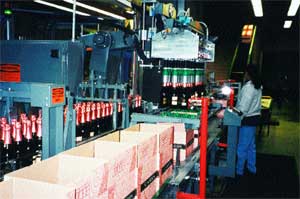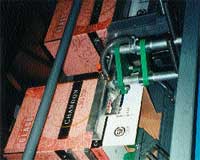Case packer sparkles at Domaine Chandon.
Sparkling wine producer Domaine Chandon, Yountville, CA, is reaping big benefits from a new case packer it installed earlier this year. Says Jim Takahashi, manager, purchasing and production quality assurance, "Five employees were required for hand-packing bottles of sparkling wine, and at best, eight percent of the bottles were suffering from label scuffing during packing. We decided the solution to these problems would be an automatic case packer."
|
Pick-and-place case packer loads two cases simultaneously. Pneumatic inflating bladders handle wine bottles gently, without damaging corks, wire hoods or foil, and essentially eliminate label scuffing during the packing process. |
Takahashi investigated a number of different types of case packers and settled on a Model 101 pick-and-place machine from A-B-C Packaging Machine Corp. that was installed last February. "We tried some drop packers and wraparound packers, but we found drop packers too worrisome for a heavy, pressurized product packed in glass, with too great a potential for breakage. Wraparound case packers would press the bottles together so the labels would get scuffed," says Takahashi.
"The pick-and-place packer is gentle and has completely eliminated the label scuffing problem."
Founded in 1973, Domaine Chandon was the first sparkling wine producer in California to be established by a French Champagne House (Moet & Chandon) using only the traditional winemaking method. Domaine Chandon's vineyards total about 1,100 acres, and it produces approximately 350,000 cases of wine a year. While best known for its sparkling wines, it also produces limited quantities of still wines.
Unit packs two 12-bottle cases simultaneously
Finished bottles of wine are conveyed single-file from the labeler past an accumulation table and are then assembled en masse at the infeed of the pick-and-place packer. The bottles are divided into three lanes as they enter the packer and come up against a pressure plate that holds them out of the pickup area. Empty, glued-bottomed shipping cases with inner partitions enter the packer on a parallel conveyor. To reduce label scuffing, the cases, which are supplied by Longview Fibre, are coated with a silicon-based compound, and the partitions, which are supplied by RTS Packaging, are made of RTS' Wineguard™ board.
At the beginning of each cycle, two empty cases are admitted to the loading area, and grids lower onto the top of the cases. The grids have conical separators at the top to direct any slightly misaligned bottles. Grid guides ensure that the partitions are located and positioned correctly. In addition, the outward-sloping tops of the grids hold the case flaps out of the way when the bottles are loaded.
Two cases of 12 bottles each are packed simultaneously, so the machine releases 24 bottles to the pickup zone each cycle. The robotic pickup assembly cycles over the bottles, descends, and places pneumatic gripper heads with internal bladders onto the bottles. When the heads, which extend well over the corks and wire hoods, are in place, the bladders are inflated with air. The pickup assembly then rises, cycles over the two shipping cases, and gently lowers the bottles into them. As the pickup assembly moves, it separates the bottles, so they fit exactly into the partitions. Thus, there is essentially no contact between the bottles and partitions, and no label scuffing. The bladders then deflate, and the assembly cycles back for the next loading cycle. The machine operates at 8 cycles/min (192 bottles/min). The packer also runs six-pack cases, loading four cases simultaneously.
"The pick-and-place system does an excellent job with our bottles. We were concerned initially that the bottle grippers might damage the wire and foil covering the corks on the bottles. However, the pneumatic inflating bladders are very gentle on the tops, and we've had no problems of this nature at all," says Takahashi.
Another feature that Domaine Chandon found very beneficial was the modem accessory that allows remote programming and troubleshooting by A-B-C personnel from their headquarters in Florida, without them having to visit the wine-making plant. Says Takahashi, "This was a big help during startup, when we found a few settings that needed to be changed. We just called their Florida office, and, after observing the machine operation over the modem, they made the changes. We haven't needed it since then, but it's very comforting to know that it's available."
|
Reciprocating robotic pick-and-place unit transfers bottles from infeed conveyor to cases, which enter machine on parallel conveyor. Grids on top of cases aid packing. |
|
Other components on the line supplied by A-B-C Packaging Corp. are a new Model 330 case erector/sealer and a Model 36 case top sealer. The erector/sealer, which uses hot-melt glue, picks flat cases from a magazine with vacuum cups and feeds them into the opening section, where an arm "over opens" the major flaps, to compensate for incorrectly slotted cases. Vacuum cups hold the case securely from below as the vacuum cup on the opening arm pulls the case open. A walking-beam case drive squares the case during transfer, and a compression mandrel with squaring lugs squares the case as compression is applied. The erector/sealer seals cases while they are on their sides, and they are tipped 90 degrees as they leave the machine, so they are upright when they reach the case packer.
The case top sealer, which also uses hot-melt adhesive, incorporates a motorized, independent, top-compression section with spring-loaded rollers to ensure square cases. "We had a taping machine, but the hot melt is more secure and indicates pilfering better," says Takahashi.
Both the case packer and erector/sealer are PLC-controlled with touchscreen operator panels and sensors that monitor machine operation. All machine functions can be operated independently from the touchscreens for setup or diagnostics, and returned to automatic operation at any time.
With the plant running multiple pack sizes, quick and easy changeover is essential. This is accomplished on all three machines with adjustable rails, hand cranks and other tool-less adjustments. For quick changeover on the case packer, the entire gripper assembly can be changed as a single unit.
Sealed cases pass by a LegiJet ML128 ink-jet coder from Weber Marking Systems that prints production date, time and product code on both sides. Using advanced piezoelectric technology, the unit prints characters ranging in height from 0.06 to 0.7 in., with a 200-dpi resolution, at speeds up to 200 fpm. It can be programmed from either a fully integrated keypad or a separate PC, and it can store up to 96 messages in its database. After printing, cases travel up an inclined conveyor and are transported to a hand-palletizing operation.
More information is available:
Case packer, erector/sealer, top sealer: A-B-C Packaging Machine Corp., 727/937-5144. Circle No. 205.
Cases: Longview Fibre, 510/569-2616. Circle No. 206.
Partitions: RTS Packaging, LLC, 770/448-2244. Circle No. 207.
Printer: Weber Marking Systems, Inc., 847/364-8500. Circle No. 208.
|
|
Case erector/sealer, which uses hot glue, picks flat cases from a magazine with vacuum cups, and feeds them into the opening section, where an arm "over opens" the major flaps to compensate for incorrectly slotted cases. |
About the Author(s)
You May Also Like







